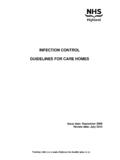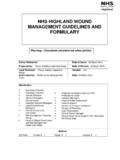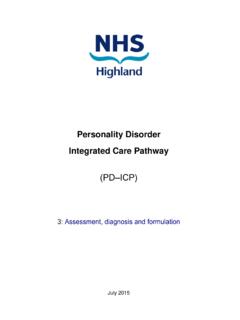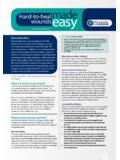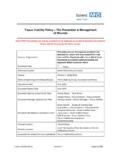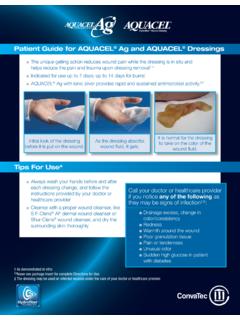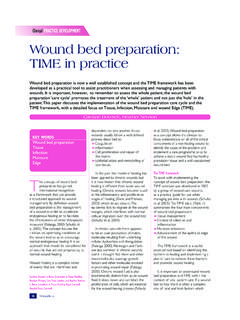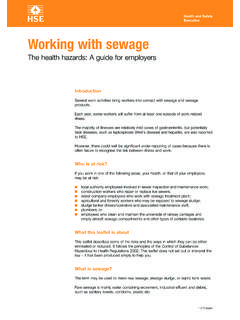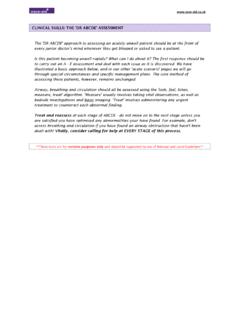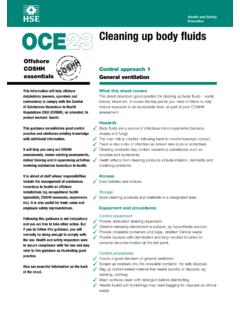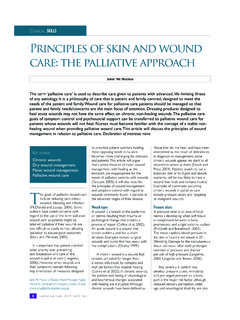Transcription of Wound Management Guidelines and Formulary - …
1 NHS HIGHLAND Wound Management Guidelines AND Formulary Policy Reference: Date of Issue: 05 March 2013 Prepared by: Tissue Viability Leadership Group Date of Review: 05 March 2014 Lead Reviewer: Tissue Viability Leadership Group Version: 2:0 Authorised by: NHSH Senior Management Team Date: 05 March 2013 Distribution Executive Directors Associate Directors Clinical Directors General Managers Clinical Leads Assistant General Managers Lead Nurses/Nurse Managers Clinical Governance Committee Risk Management Steering Group Head of Clinical Governance and Risk Management Health and Safety Professional Heads of Service/ AHP Professional Leads Network Managers Head of Public Involvement Head of eHealth Director of Occupational Health Director of Pharmacy Lead Pharmacists Clinical Dental Manager Clinical Governance Support Team Managers All Clinical
2 Staff Method CD Rom E-mail X Paper X Intranet X Warning Document uncontrolled when printed 2 NHS HIGHLAND Wound Management Guidelines AND Formulary CONTENTS PAGE NO Section One GENERAL INFORMATION Contents 2 Introduction 4 Accountability and Responsibility 5 Section Two Wound Management The Physiology of Wound Healing 6 Moist Wound Healing 7 Factors Which Affect Wound Healing 8 Wound Assessment 11 Wound Cleansing 13 Care of the Surrounding Skin 14 Interventions to Manage Exudate 15 Management of Odour 17 Infection 18 Wound Swabbing 20 Pain Control in Wound Management 21 Section Three Wound CLASSIFICATION AND TREATMENT Surgical Wound 23 Abrasions 24 Epithelialising Wound 25 Granulating Wound 26 Over Granulating Wound 27 Sloughy Wound 28 Necrotic Wound 29 Cavity Wound 30 Sinus Wound 31 Fungating Wound 32 Bites 33 Flap Lacerations 35 Blisters / Bullae 37 Thermal Injuries / Burns 38 Diabetic Foot 41 Avulsion / Ablation of Toenails 43 Leg Ulcers 44 Skin Grafts 46 Pressure Ulcers 47 Section Four PRODUCT INFORMATION Wound Management
3 (Dressing) Products 49 Secondary Dressings and Sundries 59 Section Five SPECIALIST PRODUCTS Iodine (Cadexomer Iodine) 63 Silver Products 66 Honey Products 67 Permafoam for Toe Dressings 68 Charcoal Dressing 69 Prontosan 70 Polyurethane Foam Film Dressings 71 Specialist Primary Wound Contact Layer 72 Larval (Maggot) Therapy 73 Negative Pressure Wound Therapy 77 3 Section Six APPENDICES 1. Referral Guidance for Diabetes Foot Ulcer Clinic 78 2. Offloading the Diabetic Foot Ulcer 79 3. Texas Diabetic Foot Ulcer Classification Tool 80 4. Assessment Chart for Wound Management 81 5. Pressure Ulcer Grading Tool 84 6.
4 Formulary Product Feedback Form 85 7. Photograph Consent Form 86 Section Seven GLOSSARY 87 Section Eight Formulary PRODUCT LISTS 89 4 SECTION ONE 1. Introduction The NHS Highland Wound Management Guidelines and Formulary have been developed by the Tissue Viability Leadership Group. This is a multidisciplinary group of professionals working across NHS Highland and NHS Western Isles. The aim of the Wound Management Guidelines and Formulary is to provide practitioners with guidance and a selection of products which are preferred for use in NHS Highland, based on effectiveness, suitability, acceptability and cost-effectiveness.
5 Practitioners should aim to use a product included in the Formulary in most cases and only use a non- Formulary product when there is a good clinical reason for doing so. We have provided, for a broad range of Wound types, descriptions, treatment aims and advice on the most appropriate product(s) to use. Because of the diversity of care settings across NHS Highland we have tried to provide practitioners with generic and concise, but flexible, Guidelines and Formulary . In the vast majority of cases, the products included in the Formulary are both on the Scottish National Procurement Contract (which controls products purchased by Scottish Hospitals) and The Scottish Drug Tariff (which states what can be prescribed on NHS prescription forms in primary care settings).
6 The specialist products section should only be used where there is no suitable product for a particular Wound type/clinical condition available from the standard primary and secondary product sections. If you wish a product to be considered for inclusion within the Formulary , or you wish to report back on existing products, you should complete a Formulary Product Feedback Form (SEE APPENDIX 6) and submit to the Tissue Viability Leadership Group. Contact Kathryn Bell at 5 2. Accountability And Responsibility As healthcare professionals using this Formulary you must: Use your professional knowledge, judgement and skills to make a decision based on evidence for best practice and the person s best interests.
7 You need to be able to justify the decisions that you make Ensure any advice you give is evidence based when suggesting healthcare products or services Have the knowledge and skills for safe and effective practice when working without direct supervision Recognise and work within the limits of your competence Keep your knowledge and skills up to date throughout your working life Take part in appropriate learning and practice activities that maintain and develop your competence and performance Keep clear and accurate records of the discussions you have, the assessments you make, the treatment and medicines you give and how effective these have been Complete records as soon as possible after an event has occurred Ensure any entries made in someone's paper records are clearly and legibly signed.
8 Dated and timed Ensure any entries made in someone's electronic records are clearly attributable to you Where Wound care is multi-professional and shared ensure all involved are informed of any significant change is status and/or dressing regime as soon as possible after the contact has occurred 6 SECTION TWO: 3. The Physiology Of Wound Healing Acute and chronic wounds have distinct differences. Some of the basic differences (excluding the microbiological/cellular differences) are: ACUTE WOUNDS CHRONIC WOUNDS Short duration No underlying pathology Normal inflammatory stage Usually heals without complication Acute Wound fluid supports cell proliferation.
9 Unhealed within 6 weeks of formation Underlying pathology Prolonged inflammatory stage Variety of complications may arise Chronic Wound fluid does not support cell proliferation. (Cutting & Tong 2003) The literature cites many descriptive models of healing. Whichever model is followed, it is essential to have an understanding of the basic process as this will influence decisions made in the day to day Management of the Wound . Most models suggest that the mechanics of dermal Wound healing fall largely into four overlapping phases: 1.
10 Haemostasis Bleeding starts the process of haemostasis. Blood vessels contract, platelets aggregate and a clot is formed. Leucocytes are attracted to the injured area. 2. Inflammation Prostaglandins and proteins are released, which cause vasodilation and inflammation. Neutrophils (whose function is phagocytosis of bacteria) and macrophages (which control the healing process) proliferate in the Wound . 3. Granulation New supporting tissue is formed like a scaffold, along with new blood vessel development, which is known as angiogenesis, and the Wound begins to contract.
